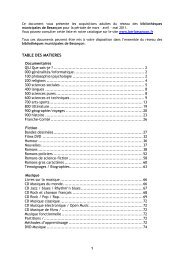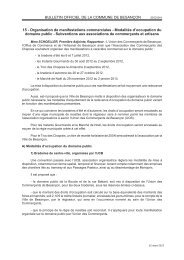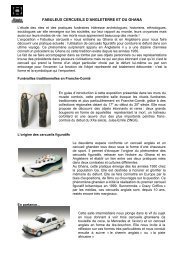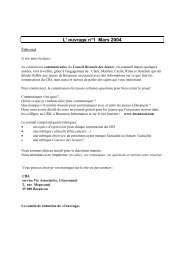An inventory of works within the city walls - Besançon
An inventory of works within the city walls - Besançon
An inventory of works within the city walls - Besançon
You also want an ePaper? Increase the reach of your titles
YUMPU automatically turns print PDFs into web optimized ePapers that Google loves.
Montmart tower<br />
Pelote tower<br />
27 28 29<br />
Thirteenth century<br />
Fifteenth and seventeenth centuries<br />
Above <strong>the</strong> Battant rise<br />
Quai de Strasbourg<br />
Also known as <strong>the</strong> square tower,<br />
it is at <strong>the</strong> centre <strong>of</strong> <strong>the</strong> Battant bastion.<br />
Probably built in <strong>the</strong> thirteenth century,<br />
it was part <strong>of</strong> <strong>the</strong> medieval porte de<br />
Battant. Vauban included it in <strong>the</strong><br />
Battant cavalier and converted into<br />
a powder store. In <strong>the</strong> nineteenth<br />
century, when <strong>the</strong> bastion cavalier was<br />
razed to <strong>the</strong> ground, <strong>the</strong> tower survived.<br />
28<br />
In <strong>the</strong> twelfth century <strong>the</strong> town<br />
consisted <strong>of</strong> two distinct districts:<br />
<strong>the</strong> ecclesiastical quarter on <strong>the</strong> slopes<br />
<strong>of</strong> <strong>the</strong> hill and <strong>the</strong> entire loop protected<br />
by <strong>the</strong> river, as well as <strong>the</strong> quarter on<br />
<strong>the</strong> right bank <strong>of</strong> <strong>the</strong> Doubs – what<br />
is known now as <strong>the</strong> quartier Battant<br />
(<strong>the</strong> Battant district) – closed <strong>of</strong>f by a<br />
defence work. In <strong>the</strong> thirteenth century,<br />
new ramparts doubled all <strong>the</strong>se lines<br />
<strong>of</strong> defence and were accompanied by<br />
a wall with about ten access portals.<br />
In <strong>the</strong> fifteenth century, <strong>the</strong> emergence <strong>of</strong><br />
fire arms necessitated <strong>the</strong> streng<strong>the</strong>ning<br />
<strong>of</strong> <strong>the</strong> fortifications. In 1475, major<br />
<strong>works</strong> were undertaken near<br />
<strong>the</strong> porte de Battant, with <strong>the</strong><br />
construction <strong>of</strong> <strong>the</strong> « tour neuve de la<br />
Pillotte » (<strong>the</strong> new Pillotte tower) which<br />
may have derived its name from <strong>the</strong><br />
Pillot family from whom <strong>the</strong> land was<br />
purchased.<br />
After <strong>the</strong> French conquest, Vauban,<br />
commissioned to renovate <strong>the</strong> town’s<br />
fortifications, kept <strong>the</strong> Pelote tower<br />
and integrated it into his ramparts. The<br />
Pelote tower was listed as a Historical<br />
Monument in 1942.<br />
Pelote counterguard<br />
Seventeenth century<br />
Quai de Strasbourg<br />
Built between 1677 and 1688, it served<br />
to protect <strong>the</strong> tower and increase its<br />
firing line by doubling it. This is a<br />
trapezoidal work, <strong>the</strong> gorge <strong>of</strong> which is<br />
parallel to <strong>the</strong> Mouillère gully.

















